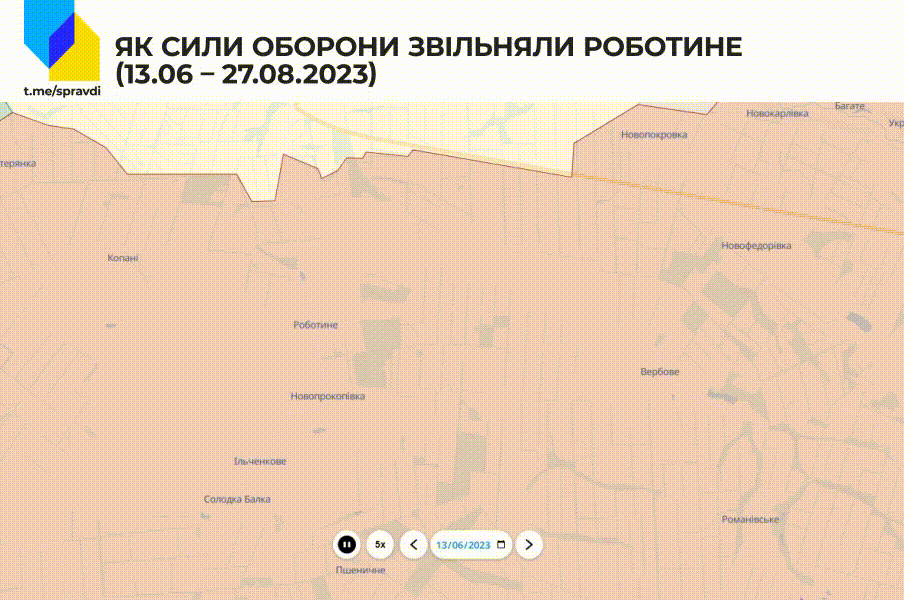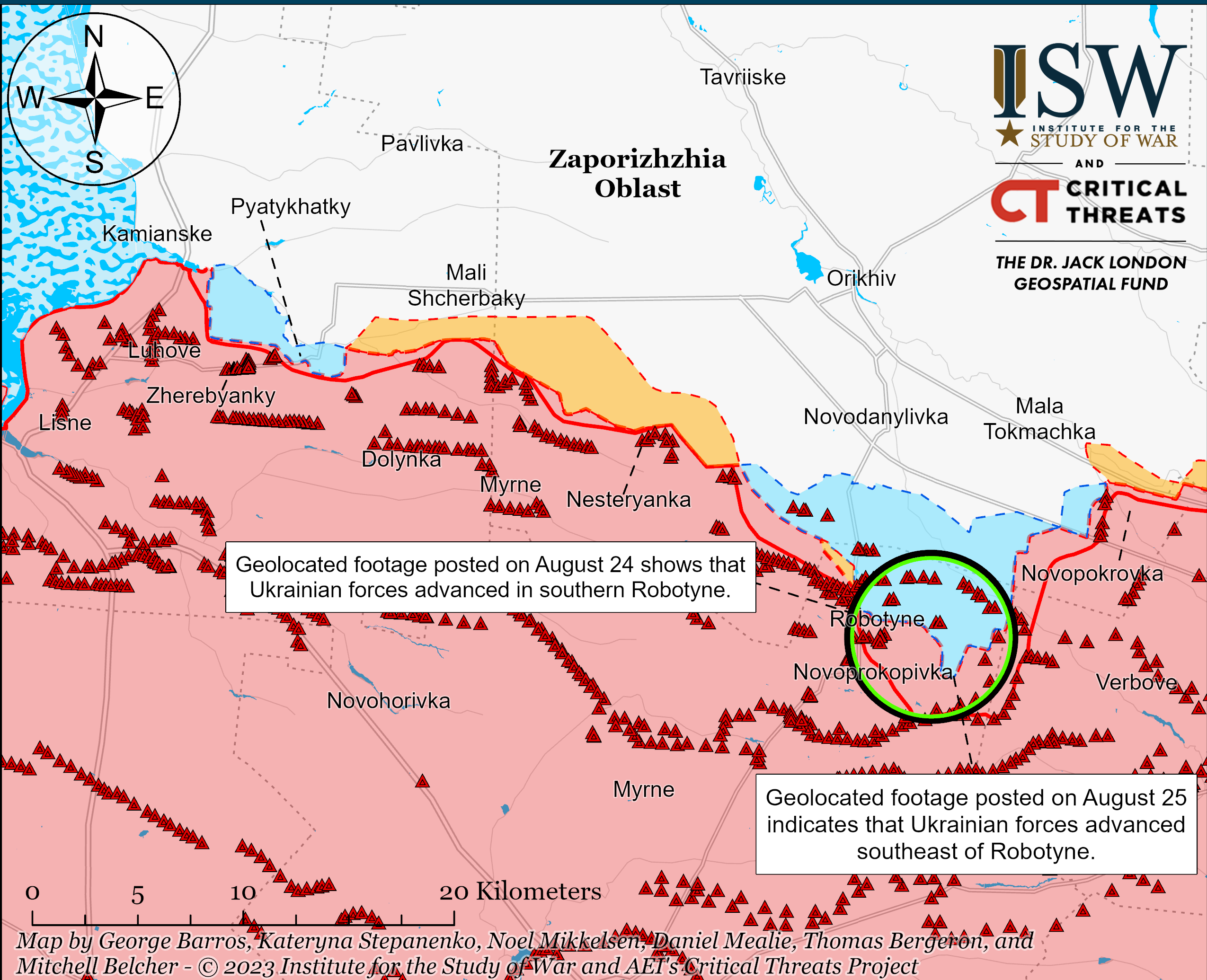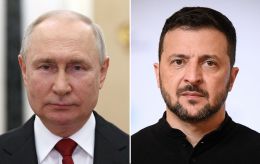Powerful breakthrough: How significant is Robotyne liberation and should we expect Ukrainian advance toward Tokmak
 Ukrainian military have broken through the Russian defense in Robotyne and are advancing to the south (photo: Getty Images)
Ukrainian military have broken through the Russian defense in Robotyne and are advancing to the south (photo: Getty Images)
Ukrainian forces have passed through Robotyne, one of the key strongholds of the Russians in the Zaporizhzhia region. What this means for advancing further in the south, and what could halt the offensive toward Tokmak - read the material by RBC-Ukraine.
Robotyne liberated
The village of Robotyne (Tokmak urban community, Polohivskyi district) with a pre-war population of about 500 people is an important settlement that witnessed heavy fighting lasting several months.
Russia occupied it in March 2022. The General Staff had been reporting successes on this front since July, and on August 22, Ukrainian forces entered the village and organized the first evacuation. It was also reported that a multi-tiered line of occupant defenses had been breached in this area.

Local residents welcomed the liberators last week (photo t.me/annamaliar)
The next day, soldiers from the 47th Separate Mechanized Brigade "Mahura" raised the blue and yellow flag over the ruined school.
Reports of the liberation of Robotyne had been circulating among experts and specialized Telegram channels for the past week. It was officially confirmed only today, on August 28. RBC-Ukraine had previously explained the reasons for such delays. The General Staff reports on the de-occupation of a particular locality only after it has been fully taken under control, and the soldiers have secured new positions and boundaries.
According to the Deputy Minister of Defense, Hanna Maliar, the southern direction remains the main focus.
"We are currently conducting offensive operations. As you know, Robotyne has been liberated. Our forces are now moving southeast of Robotyne and further south of Mala Tokmachka," she noted.
Below there is the dynamics in the Robotyne area from June 2023. Please note that the situation may differ from what is depicted.

How Ukrainian Forces liberated Robotyne (graphics based on deepstatemap.live data)
The importance of liberating Robotyne
Robotyne has particular tactical significance; in fact, Ukrainian forces shifted to a counteroffensive here in June. The local fortifications remained the main obstacle on the path to the enemy's second (main) line of defense.
Military expert Vladyslav Seleznov referred to Robotyne as a key fortified area between Orikhove and the occupied Tokmak. Approaches to it were protected by dense minefields. In part, this is why the advance was not as rapid as expected.
It's worth noting that the village is crossed by the T0408 road, and the shortest route from it to the administrative center of the community is approximately 20 kilometers. Beyond Tokmak, roads lead to Berdyansk and Melitopol.
"There's a so-called triangle whose mission is to block approaches and the land corridor to Crimea. This triangle is between the cities of Vasylivka, Tokmak, and Melitopol. And when the Ukrainian army breaks through to Tokmak, the entire Russian defensive network could seriously be disrupted," he said in a comment to RBC-Ukraine last week.
Oleksii Hetman clarifies that from a military standpoint, the village itself doesn't offer much. What's much more important are the square kilometers and what's located on them.
"Why isn't the village of paramount importance? Of course, it's important that we have liberated it. But we're not fighting for separate villages; we're trying to break through a strong defense. Therefore, the focus should not be on Robotyne itself, but on the fact that we've crossed the first line, come close to the second, and in some places, we'll soon start breaking through it," he emphasized.
According to him, it's more crucial for the military to make it harder for the enemy to move, resupply, and so on. This is why roads and dominant heights are taken under control first.
"Remember how it was near Bakhmut, and before that near Severodonetsk and Lysychansk. Fierce battles were fought not for the cities themselves but for the roads they were supplied through," he added.
Previously, it was reported about breaking through the first line in Robotyne with trenches, dense minefields, and camouflaged firing positions. Last week, there was talk of reaching the second line, where motorized infantry units, tanks, and artillery are stationed.
For more details on how the Russian defense is arranged, read the article "Mines, trenches, 'dragon's teeth': How Russia fortified itself in three defense lines, but couldn't stop Ukraine."
Directions, tactics, and intermediate goals
Ukrainian forces, following the liberation of Robotyne, continue to advance along two main lines: Novodanylivka – Novoprokopivka and Mala Tokmachka – Ocheretuvate.
"These are the directions where our Armed Forces are currently advancing," noted Hanna Maliar.
 Ukrainian forces, after liberating Robotyne, are advancing along two fronts (photo: google.com/maps)
Ukrainian forces, after liberating Robotyne, are advancing along two fronts (photo: google.com/maps)
According to assessments by analysts at the American Institute for the Study of War (ISW), the Ukrainian Armed Forces are already attacking the main complex of Russian fortifications. Reuters agency, citing an unnamed Ukrainian commander, reported that the most difficult positions have been overcome, and the offensive may proceed more smoothly.
So-called Russian "military correspondents" reported on Ukrainian attacks on supposed rear lines near the village of Verbove. Therefore, ISW believes that Defense Forces may be close to the enemy's tactical rear areas. Analysts speculate that the next defensive line may be weaker, although it still poses a significant challenge. Now, advanced units must traverse continuous anti-tank ditches, "dragon's teeth," and additional minefields.
Judging from maps, our forces have managed to wedge themselves between Robotyne and the village of Verbove, expanding the foothold by at least 7 kilometers. According to Oleksii Hetman, this is a common tactic: first, create a wedge, then expand it. Units don't stop after the breakthrough; they start moving through the enemy's hypothetical rear areas.
"Advancing too deeply is also unwise. If you advance 15-20 kilometers right away, the main units won't have time to catch up, and the vanguard could end up either in a firetrap or encircled," explained the military expert.
In turn, Seleznov emphasizes that expanding the foothold is necessary not only to avoid the risk of getting trapped but also because increasing the line of contact forces the enemy to spread their resources, reducing the density of their positions and personnel.
The advance toward Novoprokopivka and Ocheretuvate makes sense considering that these villages are located on the T0408 and T0401 roads leading to the occupied Tokmak. After the Ukrainian Armed Forces reach them, only a few kilometers will remain to the city.

The defense forces are advancing with a wedge at least 7 kilometers wide (photo: deepstatemap.live)
Hetman refers to Tokmak as an intermediate goal. The Russians have turned the city into a major logistical hub, surrounded by fortifications with anti-tank ditches. In his opinion, the enemy will fiercely defend Tokmak.
"Because further there is Melitopol, if you look at the maps, there are almost no fortifications beyond Tokmak, only checkpoints leading to Melitopol and the coast. It's not a secret that our task is to reach the Azov Sea. And if we don't manage to do that before the rainy season, then at least 15-20 kilometers from the coast to take everything under fire control, what the Russians can move from the mainland to Crimea and vice versa," he explained.
Obviously, with the liberation of Melitopol, Ukrainian forces will cut off the land corridor to Crimea and effectively split the occupied territories in the south. However, Vladyslav Seleznov refrains from drawing conclusions about Tokmak.
According to him, our army advances where it can. It's not possible to definitively state that the main forces are engaged in the direction of Tokmak.
"Only the General Staff knows the ultimate plan, the goal we're moving toward, and the method of action. Therefore, it's not advisable to unequivocally say that the direction to Tokmak is strategic," he noted.
The expert says the Russians are guessing on four southern fronts from Vasylivka (Zaporizhzhia region) to Vuhledar (Donetsk region). This keeps the enemy nervous and forces them to constantly move their operational reserves.
In the south, the enemy concentrated around 1,000 units of artillery, both small arms and rocket artillery, before our counteroffensive. And by estimates, at least 2/3 have been destroyed in nearly three months. Additional resources are being brought in, but they don't compensate for the losses, Seleznov added.
What can halt the advance toward Tokmak
Experts interviewed by RBC-Ukraine draw attention to the fact that in the area of Robotyne, where there are still defensive lines, the Russians hastily redeployed units of the 76th Guards Air Assault Division (Pskov) from the Lyman-Kupiansk direction and the 7th Airborne Division from the south of the Kherson region.
"So they've reinforced from both sides to prevent us from advancing. Will it work for them? I don't think so because the fortifications behind the first line aren't as strong. According to our intelligence and our Western partners, there are no longer 6 anti-personnel and 1 anti-tank mine per square meter, as it was before the first line," says Oleksii Hetman.

The defense of Russians in the Zaporizhzhia region (photo: infographic by ISW)
According to him, Ukrainian forces are doing everything right, following the optimal tactics of combat. But at the same time, he emphasizes that making predictions is impossible. And if the opponent deploys several more divisions, it is not excluded that the advance toward Tokmak will be halted.
"Or rain can start, which would also halt the advance. Or the heat can intensify even more. Moving in a bulletproof vest, with a helmet, carrying a full combat load, and a rifle in such heat - it also affects physical condition. We have many mobilized soldiers; they haven't undergone the same training as professional military personnel. It can be tough for them from a purely human perspective," explains the expert.
As for whether the offensive will accelerate after Robotyne, Vladyslav Seleznov is cautious in his assessments. Because of the lack of information, it's difficult to compare the density of minefields and the reliability of fortifications in the area leading to Tokmak. And the enemy is not idle, continuing to strengthen their combat formations and dig trenches.
The situation is very dynamic and depends on the capabilities of the Russian occupation army and, accordingly, the resources of the Ukrainian forces.
"Will we continue to actively conduct offensive operations? Will we have enough human, material, and technical resources? It's hard to say. But I am absolutely certain that the only serious obstacle could be the rainy season, which will start around mid-October. Under such conditions, advancing with armored vehicles will be extremely difficult," he concludes.

